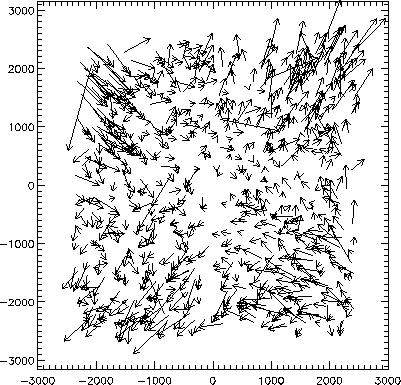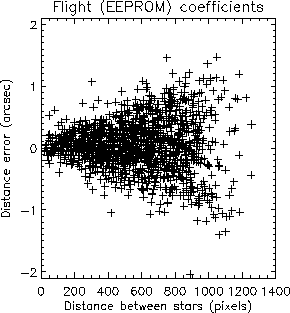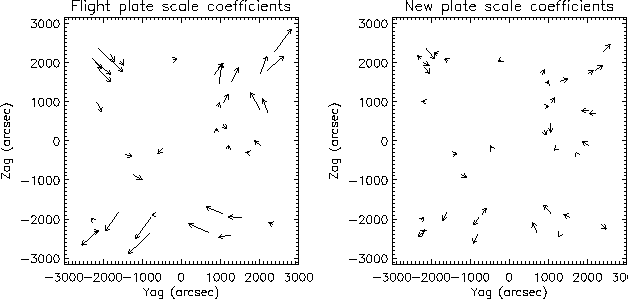Summary
The ACA plate scale calibration is a 19 coefficient polynomial (up to third order) which converts from CCD (row,col,temperature) to (Y_angle,Z_angle). A plot of the relative observed star position offsets, derived from CXC aspect pipeline processing, shows systematic residuals of up to 0.8 arcsec near the CCD corners. A refined set of calibration coefficients has been derived by using the distance between 1360 star pairs from 266 Chandra science observations. The plate scale coefficients were varied in order to minimize the summed squared difference of the observed angular separation minus the actual (catalog) angular separation. Ten observations have been reprocessed through the aspect pipeline with the new coefficients, and now show substantially reduced relative offsets.Original star offsets plot
CXC aspect solution data for 164 short observations were analyzed to determine the offset of observed versus predicted star positions (in ACA angular coordinates). The prediction is based on the star RA and Dec and the aspect solution, and is therefore a relative quantity. If one star has a large offset, this will pull the aspect solution away from the true attitude, so the individual offset will be reduced. Nevertheless, since there are typically 5 guide stars distributed at random throughout the field, this method gives a good qualitative diagnostic of any plate scale errors. The plot below shows the offsets, where each arrow represents the offset for a single guide star. Each observation normally contributes five arrows to the plot. The offsets have been scaled by a factor of 1000, so an arrow which is 1000 arcsec long on the plot is actually 1 arcsec. There is clearly a systematic trend of large residuals in the corners.
Derivation of revised plate scale coefficients
Because there is no absolute measure of the Chandra attitude, it is difficult to directly calibrate the plate scale using individual star measurements. One possible technique would be to use 4 of the 5 stars to derive the attitude and then calibrate with the 5th. Unfortunately deriving the aspect solution (using the CXC aspect pipeline) is fairly slow and cumbersome, and doing this for several hundred stars is impractical.An alternate technique is to use the relative separation of many star pairs to constrain the plate scale. Given the location of each star in pixel coordinates, derived using elliptical gaussian centroiding via the aspect pipeline, one can predict the angular separation of the two stars. This depends of course on the plate scale polynomial coefficients. The predicted separation can then be compared to the true separation on the sky based on catalog RA and Dec for each star. In the data set used here, there were a total of 1360 unique star pairs. An IDL code using the Powell minimization method was written to optimize the plate scale coefficients to minimize the sum of the square of the differences between the predicted and catalog separation.
Since all the data are at one temperature, the polynomial terms involving temperature were left fixed. Similarly, since there is only relative separation information, the constant terms were not varied. This leaves the terms for C, R, C^2, R^2, C*R, R*C^2, C*R^2, C^3, and R^3.
The results of the minimization are given in the plot below, which shows the separation residual (predicted - catalog) as a function of separation angle (pixels).


The left plot shows the residuals using the flight coefficients which are encoded in the ACA EEPROM. The right panel shows the reduced residuals after optimizing the plate scale coefficients. The RMS of the residuals is reduced from about 0.29 arcsec for the flight values to 0.13 arcsec for the new, optimized, parameters. Even with the new coefficients, there are still some outliers. One of these outliers was examined in detail and found to be due to a catalog error in the star position, which will be corrected in the latest (final) release of the Chandra acquisition and guide star catalog. The new and flight values of the polynomial coefficients are given below:
NEW COEFFICIENTS FLIGHT (EEPROM) COEFFICIENTS
PRIM STAR Y PRIM STAR Z PRIM STAR Y PRIM STAR Z
------------- ------------- ------------- -------------
0 3.0346485e+01 -2.4650391e+01 3.03464844e+01 -2.46503906e+01 1,
1 8.2320580e-03 4.9959106e+00 9.38110352e-03 4.99642792e+00 c,
2 -4.9955368e+00 9.2384126e-03 -4.99528198e+00 9.14611816e-03 r,
3 0.0000000e+00 0.0000000e+00 0.00000000e+00 0.00000000e+00 t,
4 -1.3760260e-06 2.4250173e-06 -1.14440918e-06 2.53915787e-06 c*c,
5 -1.0995453e-06 4.5665101e-06 -1.19805336e-06 3.72529030e-06 c*r,
6 7.6234342e-06 -1.2567043e-04 7.62343407e-06 -1.25670433e-04 c*t,
7 -6.2085660e-06 1.2543605e-06 -5.62667847e-06 1.03116035e-06 r*r,
8 1.4052392e-04 -1.2580157e-04 1.40523911e-04 -1.25801563e-04 r*t,
9 0.0000000e+00 0.0000000e+00 0.00000000e+00 0.00000000e+00 t*t,
10 5.4853988e-10 -1.2083737e-07 4.65661287e-11 -1.20745972e-07 c*c*c,
11 1.1700483e-07 -3.3289918e-10 1.17020682e-07 -3.25962901e-10 c*c*r,
12 1.0686927e-08 -9.3597921e-09 1.06869265e-08 -9.35979187e-09 c*c*t,
13 -1.4727110e-10 -1.1736237e-07 -2.09547579e-10 -1.18976459e-07 c*r*r,
14 -2.5611371e-09 -6.5192580e-09 -2.56113708e-09 -6.51925802e-09 c*r*t,
15 -4.7427602e-07 -1.4187768e-06 -4.74276021e-07 -1.41877681e-06 c*t*t,
16 1.1861290e-07 -3.3820965e-10 1.18394382e-07 -3.72529030e-10 r*r*r,
17 -3.7020071e-09 1.0384246e-08 -3.70200723e-09 1.03842467e-08 r*r*t,
18 5.0647651e-07 4.4633171e-06 5.06476499e-07 4.46331687e-06 r*t*t
Comparison of flight versus new coefficients
A graphical representation of the difference between the flight and new coefficients is shown below. Over a grid of row and column positions, Y_angle and Z_angle have been computed using both the flight and new coefficients. The vector difference is then plotted, again scaled by a factor of 1000. Although it shows some of the same qualitative characteristics of the first offsets plot (above) using aspect pipeline data, it is not completely consistent. This is a little disturbing, since one would expect to see the exact same pattern of residuals.

Details
The analysis was done in the directory/home/aldcroft/Aspect/flt/aca_plate_scaleThe original star offset data and analysis programs are located in
/home/aldcroft/Aspect/flt/star_offsets
The IDL code to optimize the plate scale coefficiences is fit_ps.pro.
Key files in the aca_plate_scale directory:
NOTES Notes from analysis calc_ps_sigma.pro Calculate "sigma" for each polynomial coefficient clean_plate_scale.* Plate scale data with repeated stars removed clean_ps_data.pl Remove repeated stars dist_cal.dat Final plate scale coefficients based on fitting eeprom_cal.* Flight plate scale coefficients extract_info.pro Extract centroids and star info from pipeline products find_old_offsets.pl Pull out flight offset values for newly processed obsids fit_ps.pro Determine new plate scale coefficients get_ps_data.pl Get data from archive for fitting plate scale new_fdc.fits New FDC ARD file used in pipeline processing new_offsets.dat Data file with offsets after processing with new FDC file obs* Directories for reprocessing old_fdc.fits Old (CALDB) FDC ARD file used in pipeline processing old_offsets.dat Data file with offsets from archive plate_scale.dat Output of get_ps_data.pl. Contains repeated stars. plot_*.pro Make some plots short_obs.rdb List of obsids used for get_ps_data.pl update_fdc.pl Update the primary star Y and Z coefficients in the FDC ARD verify.csh Do pipeline reprocessing

Aspect Information main page
Comments or questions: Tom Aldcroft
Last modified:01/08/02